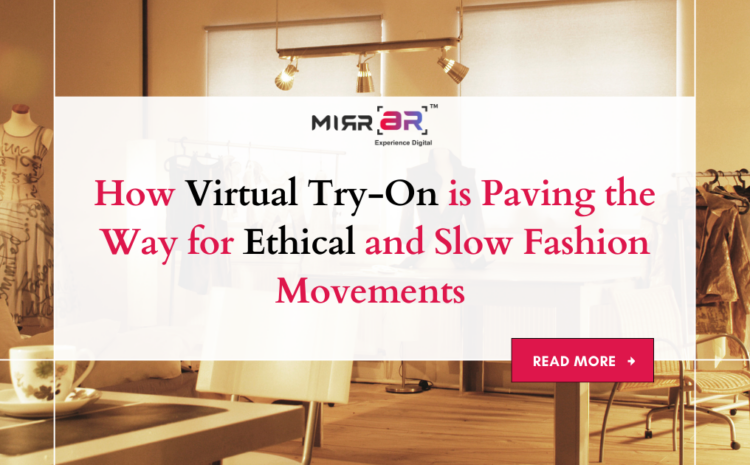In an era of conscious consumerism, where shoppers are increasingly aware of the environmental and ethical impact of their purchases, the fashion industry is undergoing a significant transformation. The fast fashion era, defined by mass production and quick consumption, is slowly being replaced by a more responsible alternative — slow and ethical fashion. Central to this transition is Virtual Try-On (VTO) technology, particularly innovative solutions like MirrAR VTO, which are revolutionizing how consumers shop, engage, and make decisions.
Understanding the Shift: From Fast to Slow Fashion
Slow fashion champions quality over quantity, mindful manufacturing, ethical labor practices, and long-lasting clothing. It’s a movement rooted in sustainability, encouraging buyers to purchase fewer items that last longer. However, adopting slow fashion requires a change not only from brands but also from consumers who have become accustomed to convenience and instant gratification.
That’s where virtual try-on steps in — bridging the gap between digital convenience and conscious shopping.
Virtual Try-On: Empowering Conscious Choices
One of the key challenges in the fashion industry is the high rate of returns. Often, customers buy multiple sizes or styles online, try them on at home, and return what doesn’t work — leading to immense logistical waste, packaging issues, and carbon emissions. MirrAR’s Virtual Try-On technology allows consumers to “try before they buy” — digitally and accurately.
By providing a realistic visualization of how a garment or accessory looks on the individual, VTO eliminates uncertainty, reducing the need for over-purchasing and returns. This not only helps customers make informed and confident decisions but also reduces waste generated by reverse logistics.
Supporting Sustainable Production Models
For ethical and slow fashion brands, producing small, limited collections is a key principle. But convincing customers to purchase higher-priced, ethically made pieces without physical trials is a hurdle. With MirrAR VTO, brands can offer a virtual showroom experience that captures the essence of their craftsmanship and detail, without needing vast physical inventories.
This allows brands to test new styles virtually, collect consumer feedback, and produce based on demand — aligning perfectly with made-to-order and zero-waste production models.
Also Read: The Intersection of AI, Fashion, and Virtual Try-On: A Look at the Future
Encouraging Mindful Consumption
Virtual Try-On brings a shift in the consumer mindset from impulsive purchases to thoughtful consideration. Instead of mindlessly adding items to the cart, shoppers can now take their time exploring different looks, styles, and fits in a virtual environment. This interaction promotes emotional connection with a product — a key factor in slow fashion, where longevity and attachment to garments are valued.
When customers can see themselves in a product and truly envision wearing it, they are more likely to treasure it longer and buy less frequently — directly supporting sustainability goals.
Reducing the Carbon Footprint of Fashion
Shipping, returning, and managing unsold stock are major contributors to the fashion industry’s environmental footprint. By integrating MirrAR’s VTO into e-commerce platforms and retail stores, brands significantly lower the dependency on physical trials and transportation. This, in turn, helps minimize emissions, reduce packaging waste, and streamline inventory management.
Moreover, with VTO’s integration into digital campaigns and social media, brands can launch collections virtually, reducing the need for extravagant in-person fashion shows and photoshoots — yet another step toward greener practices.
Enhancing Transparency and Storytelling
Ethical and slow fashion brands rely heavily on storytelling — about the artisans, the materials, and the journey of each product. VTO platforms like MirrAR can integrate these stories into the try-on experience, offering a multisensory journey that’s not just about how the product looks but also about what it represents.
Imagine trying on a handcrafted piece and instantly learning about the weaver in Rajasthan who made it or the organic cotton farm it came from — such experiences build trust, loyalty, and deeper appreciation for the item.
Accessibility and Inclusion
Slow fashion should not be a luxury only for a few. By making virtual try-on accessible across devices and geographies, MirrAR empowers a wider audience to explore and engage with ethical fashion brands. No longer confined to metropolitan flagships or elite boutiques, ethical fashion can now be virtually showcased to a global audience — expanding its impact and reach.
A New Era of Conscious Retail
Virtual Try-On is not just a technological innovation; it’s a movement enabler. It aligns perfectly with the values of the slow fashion community — reducing waste, promoting mindful consumption, supporting small-batch production, and creating emotional engagement.
Brands that embrace tools like MirrAR VTO are not only enhancing their customer experience but also committing to a better future — for fashion, for the planet, and for society.
Final Thoughts
As the lines between tech and sustainability blur, tools like Virtual Try-On are proving to be powerful allies in the ethical fashion revolution. For luxury and emerging brands alike, adopting MirrAR’s VTO technology isn’t just about staying competitive — it’s about leading responsibly.
By empowering shoppers to buy better, not more, and enabling brands to produce smarter, not faster, Virtual Try-On is paving the way for a truly sustainable fashion ecosystem.
